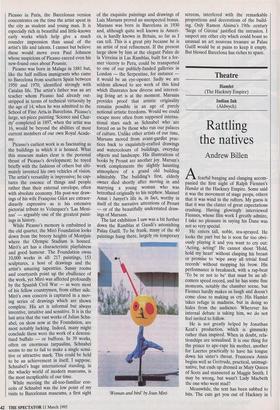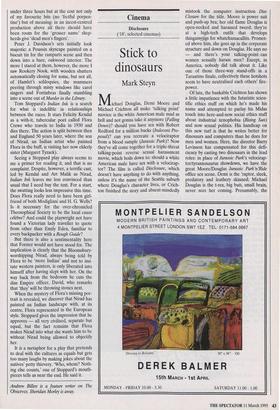Theatre
Hamlet (The Hackney Empire) Indian Ink (Aldwych)
Rattling the natives
Andrew Billen
Afearful banging and clanging accom- panied the first night of Ralph Fiennes's Hamlet at the Hackney Empire. Some said it was the movement of stage props, others that it was wind in the rafters. My guess is that it was the clatter of great expectations crashing. Having glowingly interviewed Fiennes, whose film work I greatly admire, I take no pleasure in saying his Dane was not so very special.
He enters tall, noble, sea-sprayed. He looks the part but he is soon far too obvi- ously playing it and you want to cry out: `Acting, acting!' He cannot shout 'Hold, hold my heart' without clasping his breast or promise to 'wipe away all trivial fond records' without mopping his brow. His performance is breakneck, with a rap-beat `To be or not to be' that must be an all- corners speed record, and he has some fine moments, notably the chamber scene, but Fiennes hardly makes us laugh and doesn't come close to making us cry. His Hamlet takes refuge in madness, but in doing so hides from the audience. Wherever his internal debate is taking him, we do not feel invited to follow.
He is not greatly helped by Jonathan Kent's production, which is gimmicky rather than inspired. When in doubt, rela- tionships are sexualised. It is one thing for the prince to ape-rape his mother, another for Laertes practically to have his tongue down his sister's throat. Francesca Annis begins well as Gertrude, practical, unimagi- native, but ends up dressed as Mary Queen of Scots and mannered as Maggie Smith. I may be wrong, but wasn't Lady Macbeth the one who went mad?
Meanwhile, the text has been subbed to bits. The cuts get you out of Hackney in under three hours but at the cost not only of my favourite bits (no 'fretful porpen- tine') but of meaning: in an incest-centred production above all there should have been room for the 'grosser name' shep- herds give 'dead men's fingers'.
Peter J. Davidson's sets initially look majestic: a Poussin skyscape painted on a biscuit tin for the ramparts scene. and then down into a bare, oakwood interior. The more I stared at them, however, the more I saw Rookery Nook, with wooden shutters automatically closing for some, but not all, of Hamlet's soliloquies, the mummers peering through misty windows like carol singers and Fortinbras finally stumbling into a scene out of Murder in the Library.
Tom Stoppard's Indian Ink is a search for what is indelible in relationships between the races. It stars Felicity Kendal as a with-it, tubercular poet called Flora Crewe who travels to India in 1930 and dies there. The action is split between then and England 50 years later, where the son of Nirad, an Indian artist who painted Flora in the buff, is visiting her now elderly sister (Margaret Tyzack).
Seeing a Stoppard play always seems to me a primer for reading it, and that is no complaint. Despite, however, a terrific cast, led by Kendal and Art Malik as Nirad, Indian Ink leaves me less convinced than usual that I need buy the text. For a start, the swatting looks less impressive this time. Does Flora really need to have been girl- friend of both Modigliani and H. G. Wells? Is it necessary for the over-chronicled Theosophical Society to be the local cause celebre? And could the playwright not have found a Victorian lady traveller to quote from other than Emily Eden, familiar to every backpacker with a Rough Guide?
But there is also a sentimentality here that Forster would not have stood for. The implication is clearly that the Bloomsbury- worshipping Nirad, always being told by Flora to be 'more Indian' and not to imi- tate western painters, is only liberated into himself after having slept with her. On the way back from the bedroom he cuts the dim Empire officer, David, who remarks that 'they' will be throwing stones next.
When the mystery of Flora's missing por- trait is revealed, we discover that Nirad has painted an Indian landscape with, at its centre, Flora represented in the European style. Stoppard gives the impression that he approves — all very civilised, separate but equal, but the fact remains that Flora makes Nirad into what she wants him to be without Nirad being allowed to objectify her.
It is a metaphor for a play that pretends to deal with the cultures as equals but gets too many laughs by making jokes about the natives' petty thievery. 'Who, whom? Noth- ing else counts,' one of Stoppard's mouth- pieces tells us near the end. He said it.
Andrew Billen is a feature writer on The Observer. Sheridan Morley is away.



























































 Previous page
Previous page